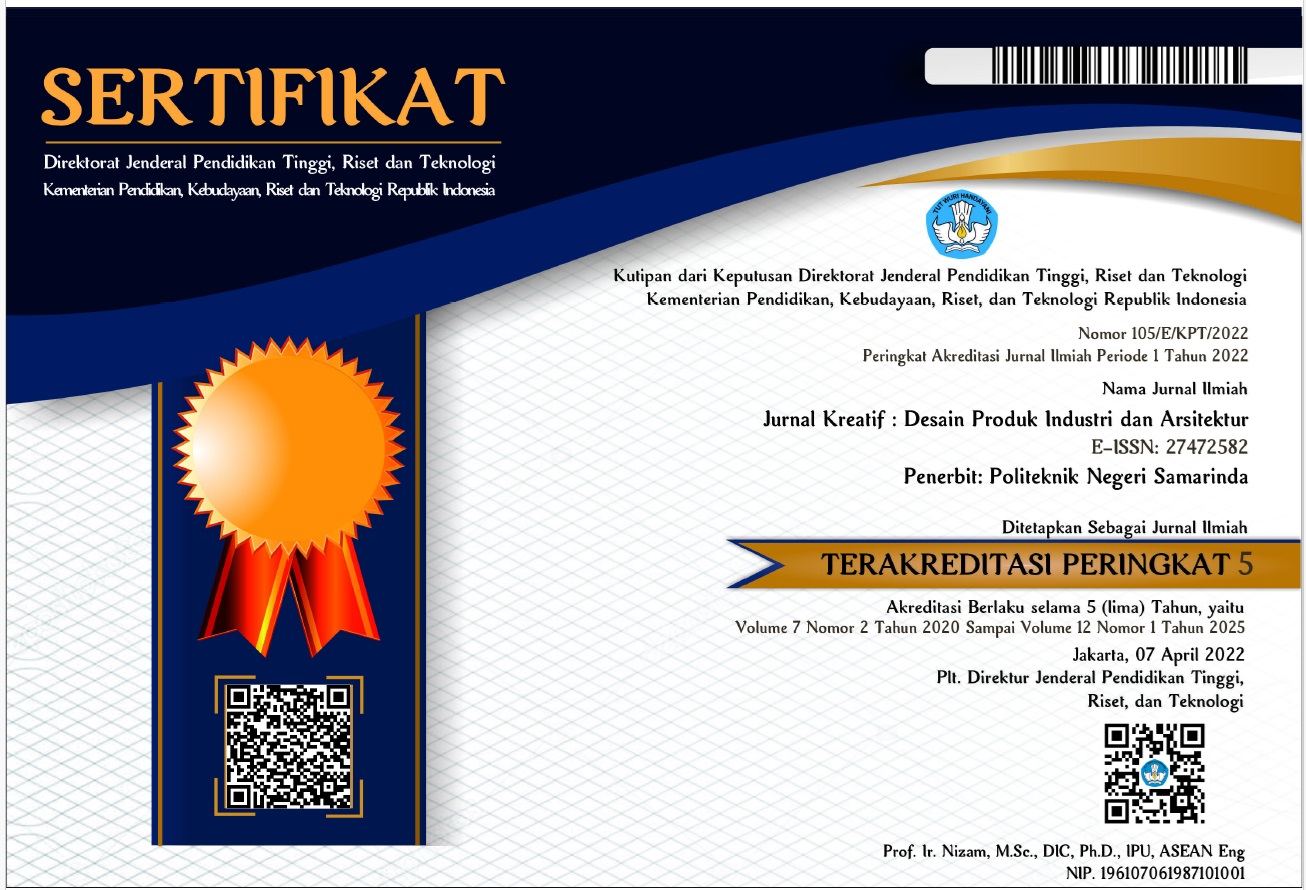PERANCANGAN KAP LAMPU DEKORATIF BERBAHAN BIO LEATHER KACANG KEDELAI
 Abstract views: 685
,
Abstract views: 685
,
 pdf downloads: 581
pdf downloads: 581
Abstract
Soybean shell waste contains organic material with pH levels classified as acidic which can endanger environmental sustainability and pollute water and soil. This research raises the issue of utilizing soybean shell waste into more useful products. Soybean shell waste is used as new materials in the form of composites to be used as products that have economic value and overcome negative environmental impacts. The composite results in this study in this study were in the form of soybean skin bio leather sheets which were then analyzed for raw material talent to determine the potential of soybean skin bio leather sheets to be used as alternative product design materials. The actions taken to identify the talent of the sheet are by exploring and testing the translucency of the light to determine the distribution of the light produced, testing the sustainable sheet with the process of soaking the soil and water, and giving color. After analyzing material talent, in product design using the MACAK design method in the design so that product recommendations are found using soybean skin bio leather material. One of the product recommendations that can be developed is the design of a decorative lampshade with a Scandinavian concept with a weaving technique with a zig zag motif and geometry for hanging wall lamps, and table lamps using soybean skin bio leather. The results of the product design of hanging decorative lampshades, table lamps
Downloads
References
[2] B. S. Nasional, Tempe: Persembahan Indonesia untuk Dunia. 2012.
[3] N. Iryani, "Pengaruh Penggunaan Kulit Ari Biji Kedelai sebagai Pengganti Jagung dalam Ransum Terhadap Kecernaan Energi, Protein, dan Kinerja Domba," J. Produksi ternak, vol. 2, 2001.
[4] M. Faisal, F. Maulana, P. N. Alam, and H. Daimon, "Wastewater characteristics from tofu processing facilities in Banda Aceh," presented at the The 4th Annual International Conference Syiah Kuala University, Aceh, 2014.
[5] F. Belen, J. Sanchez, E. Hernandez, J. M. Auleda, and M. Raventos, "One option for the management of wastewater from tofu production: Freeze concentration in a falling-film system," Journal of Food Engineering, vol. 110, no. 3, p. 10, 2012.
[6] B. Sarwono and Y. P. Saragih, Membuat Aneka Tahu. Jakarta: Penebar Swadaya., 2001.
[7] W. Cahyadi, Teknologi dan Khasiat Kedelai. Jakarta: Bumi Aksara, 2007.
[8] Hartono, M. Rifai, and H. Subawi, Teknik Pengenalan Komposit. Yogyakarta: Deepublish, 2016.
[9] "Google image." (accessed.
[10] W. A. Guspara, Pendekatan Material Sebagai Alternatif Untuk Pengembangan Produk. Yogyakarta: Universitas Kristen Duta Wacana, 2017.
Copyright (c) 2022 Antonius Christanto Gunawan, Sekar Adita, Purwanto

This work is licensed under a Creative Commons Attribution-ShareAlike 4.0 International License.
Authors who publish with this journal agree to the following terms:
- Copyright on any article is retained by the author(s).
- The author grants the journal, right of first publication with the work simultaneously licensed under a Creative Commons Attribution License that allows others to share the work with an acknowledgment of the work’s authorship and initial publication in this journal.
- Authors are able to enter into separate, additional contractual arrangements for the non-exclusive distribution of the journal’s published version of the work (e.g., post it to an institutional repository or publish it in a book), with an acknowledgment of its initial publication in this journal.
- Authors are permitted and encouraged to post their work online (e.g., in institutional repositories or on their website) prior to and during the submission process, as it can lead to productive exchanges, as well as earlier and greater citation of published work.
- The article and any associated published material is distributed under the Creative Commons Attribution-ShareAlike 4.0 International License













